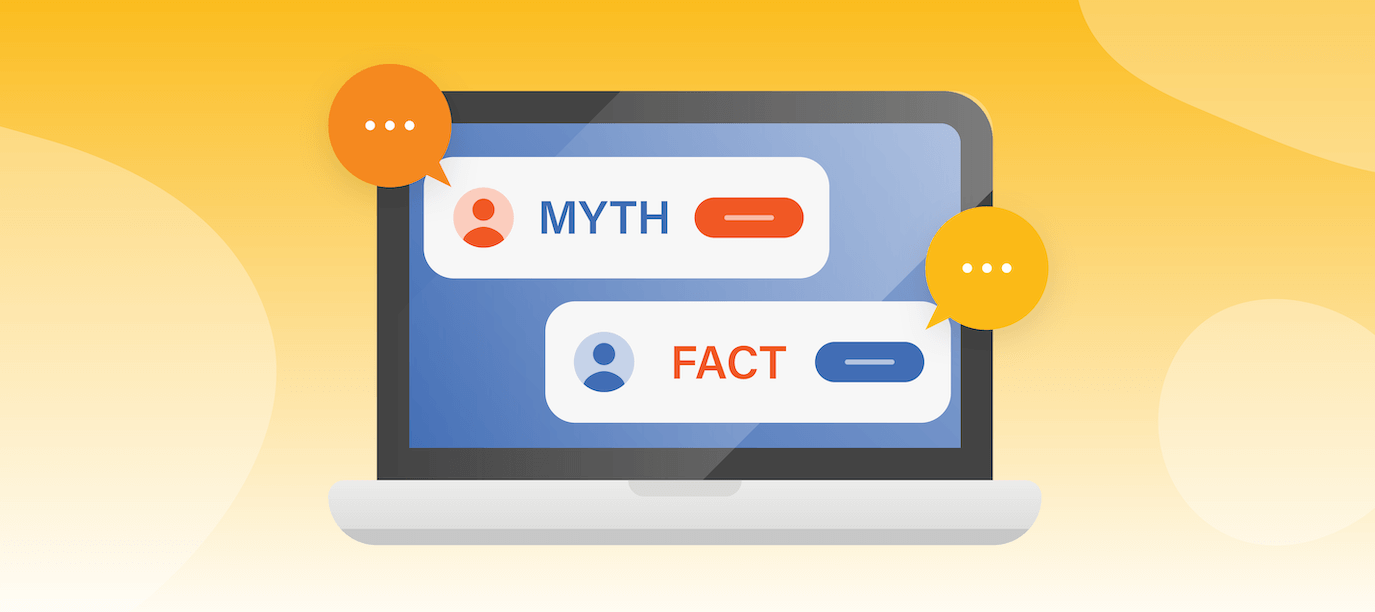
Discrediting the Most Common Misconceptions
With the help of technological change, digital marketing has greatly altered the way businesses can reach new and existing customers today. Digital marketing allows businesses to not only target niche markets, in real time, but to foster relationships and manage reputation. However, there are a ton of misconceptions about digital marketing out there that you may be questioning. You may also be wondering how you can specifically use digital marketing for your particular business. If digital marketing overwhelms you, don’t worry! We’re here to go over some of these misconceptions and give you the lowdown on what’s really true.
Misconception 1: “Digital Marketing isn’t accessible for my small business.”
Truth: It’s a pretty common misconception that only big businesses can afford and truly benefit from the use of digital marketing – but that’s just not the case. It can actually be very cost efficient for small companies, as it doesn’t always require large investments, and there are plenty of platforms and options that are small-business friendly. Plus, whatever you put into digital marketing, you’re very likely to get back (and then some). In fact, brands that use omnichannel marketing (a tactic that highly utilizes digital) retain 89% of their customers. Additionally, 72% of customers say they’d rather be contacted by brands through multichannel marketing – another tactic on several print and digital mediums.
51% of companies today use at least eight channels to interact with customers, and, according to a recent study, Americans now spend over 11 hours per day on electronic media. So, if you’re a small company that’s only using one or two channels (none of which are digital) there’s likely – almost definitely – a revenue loss.
Digital marketing also helps with conversions. How so? For example, companies that use social media as part of their digital marketing strategy produce 78% more business than those not using social media. And, digital welcome emails (emails aimed towards new customers, welcoming them and usually offering discounts, coupons, and so on) convert 51.94% of customers.
When it comes to digital marketing for small businesses, it all comes down to targeting the right audience with the right digital tactics. Thankfully, most digital marketing tools give you the chance to hone in on those who would be most receptive to your digital ads, email campaigns, social posts, and so on. With digital tools, you can manage consumer data and engagement and can highly personalize your communication. In turn, this helps you improve customer relationships among those who matter, which for small businesses is really all that matters.
Misconception 2: “My digital marketing plan is putting up a website. That’s enough – right?”
Truth: We’ve heard it before, and it pains us to see it! Designing a website – or any digital marketing component, for that matter – and never looking at it again, is almost worse than not having it at all. Why? For most potential and current consumers, a company’s website is the first place they look for information. If the website hasn’t been regularly updated with new branding, products, content, and more, you run the risk of looking like you don’t care, don’t operate well, are out of date, or worse – are no longer open. Digital marketing is all about being present and staying on trend. It’s important to be aware of the impact your website has and how it is not a standalone piece, but a piece of the larger digital puzzle.
Not only is it essential for you to always update your site, but to create and have a social media presence. Similarly, you don’t want this digital tool to go stale. If you do have social, you should be responding and engaging with customers and showing that you’re active and available. Social media can be an excellent marketing tool to reach, nurture, and engage with customers – if used correctly. By engaging with your customers, you add humility to your brand rather than just feeling like a flat business with products and services but no personality.
Both your website and social media can help your company create and keep a good reputation. Creating social media and Google accounts for your business gives customers the space to leave comments and reviews and gives you and other potential customers higher visibility. While word of mouth marketing is great, and customers are more likely to trust other customers and their reviews about a product, service, or company rather than the company itself, we live in a highly digital world. 90% of customers will choose a product that comes with a person’s recommendation (even if they don’t know that person).
Lastly, if your company happens to receive a bad review on one of these platforms, you now have the opportunity to reach out and mend the issue in a professional way – for the world to see. This scenario is a whole lot better than negative reviews through word of mouth, because with digital, you get the chance to respond and recover.
Overall, companies should be accessible on multiple platforms and continue to update those platforms. In doing so, you’re given the ability to reach more customers, leading to higher conversion rates, revenue, and customer loyalty.
Misconception 3: “I can just stick to traditional, non-digital marketing only.”
Truth: While traditional marketing is great and works well for a ton of companies, it primarily works well if it’s dusted with digital tactics and touchpoints. Digital marketing and digital touchpoints (such as QR codes, links, and personalized links) can add to any campaign by providing direct and more accurate results and data.
With just “push” marketing alone (ex: billboards, tv/radio ads, cold calling, etc.), without any digital touchpoints, it can be hard for businesses to measure the effect each campaign has on conversions and brand awareness. It can also be difficult to really know the demographic that’s most receptive to your traditional marketing (or if people even see, read, or hear it in the first place!).
Marketing strategies that incorporate digital tactics and touchpoints make it much easier to figure out what campaign components (for example, email, display ads, banner ads, social media, direct mail, print ads, etc.) get the most exposure and clicks. With the help of tools like Google Analytics and CRM platforms, you can see metrics such as website visits, click-throughs, time spent on a component, and more. And with this information, you can focus your attention on running campaign components that produce results.
Overall, with a combination of digital and print marketing, you can receive higher ROI, reach a broader and more diverse audience, or oppositely, reach a very niche, target audience, and get high campaign exposure through multiple devices and mediums. Even if you do get exposure through traditional mediums, using digital touchpoints like QR codes, PURLs, personalization, and more, is always better and more measurable.
Misconception 4: “All my digital marketing has been tested on my computer screen and looks good. I’m good to go, right?”
Truth: With the increasing amount of time people spend on their phones – websites, ads, emails, videos, and other digital marketing tactics need to be just as accessible, and fit just as well, on a smartphone screen. We call this the mobile-first perspective. These days, ensuring your content fits to the mobile screen is first and foremost.
Why’s this important? Let’s go through a couple examples. Let’s say someone is new to your neighborhood, looking for a doctor, and happens to drive by one. They might be interested in learning more. The likelihood that they wait until they get home to search on their desktop computer or laptop is minimal. Instead, they’ll use their phone. If they look up your business and your website is not fit for mobile use, they’ll get confused and/or frustrated and close out of it, causing you to lose their business. Plus, when they close out of your website, they’re likely to end up at the business of your competitor somewhere down the line. Another example – someone has just joined your company’s email newsletter. They get their first email and open it up on their phone, only to be unable to read the small text and to see that some images are distorted, too large, or cut off the screen. Why is this? You forgot to design for mobile. If this customer gets frustrated enough to unsubscribe, you could miss out on a long-term consumer relationship, referrals, opportunities, and who knows what else!
Today’s consumers are all about speed, personalization, price, and getting help fast. After all, mobile devices drove 61% of visits to U.S. websites in 2020, up from 57% in 2019. Improve your potential customers’ overall experience before they even talk to you by making a good mobile impression, first. This is not to say that “desktop is dead”, because depending on your demographic, desktop could be your customer’s go-to search tool. We’re just saying that mobile is always something to highly consider, as it’s rapidly becoming more and more used for search.
While you could create an app for mobile use instead of a website, most customers are simply visiting your site to do preliminary research on your brand. More than likely, they’ll see downloading the app and creating an account as too much work, and could ultimately, again, rule your business out. So, your best bet? – mobile-first.
Now that you can see how crucial digital is to marketing success, and are aware of the many common misconceptions and the truth behind them, it’s time to figure out the best path for you and your business. If you’re unsure where to start, feel free to give us a call so we can help you find the starting point of your digital marketing journey!
Back to Blog

